You can create a powerful wasp repellent spray by mixing equal parts white vinegar and water with several drops of dish soap. Enhance effectiveness by adding 4-10 drops of essential oils like peppermint, clove, or lemongrass per 16oz. Apply during early morning or evening when wasps are less active, targeting entry points, patios, and previous activity sites. Reapply every 1-2 weeks and after rain for continuous protection. These strategic techniques will help you optimize your homemade solution.
Create Your Own Vinegar-Based Wasp Spray Formula
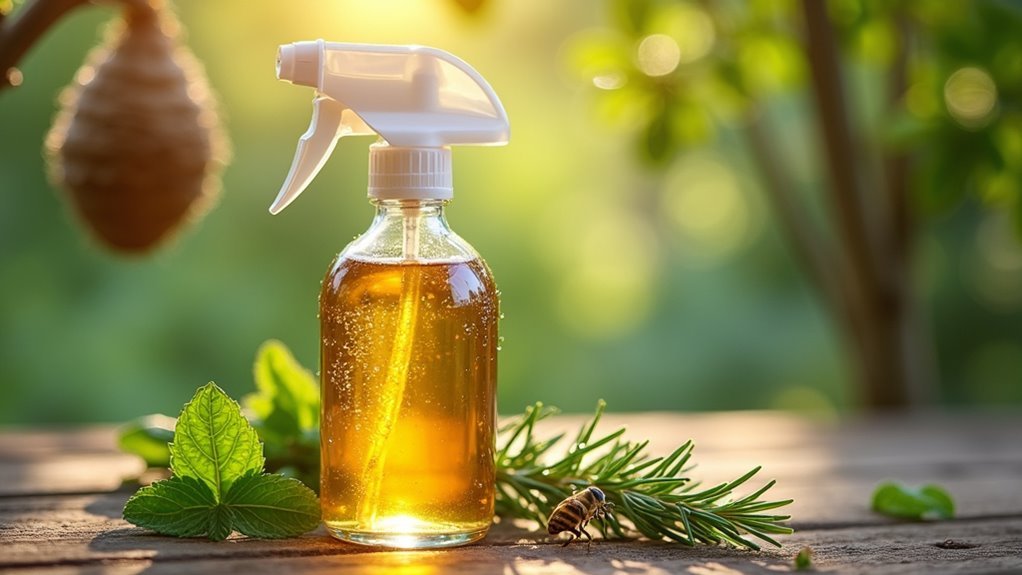
When wasps threaten your outdoor enjoyment, you can quickly create an effective natural repellent using simple household ingredients. Your homemade vinegar spray requires just three basic components: equal parts water and white vinegar, plus several drops of liquid dish soap.
Mix these ingredients thoroughly in a spray bottle to create your natural repellent. The vinegar’s pungent odor disrupts wasps’ scent navigation system, making this solution particularly effective against these aggressive insects.
The dish soap enhances the mixture’s effectiveness by helping it adhere better to surfaces and nest areas. This eco-friendly formula offers a safe alternative to harsh chemical pesticides, protecting your family and pets while effectively deterring wasps from invading your outdoor spaces without causing environmental harm.
Essential Oil Combinations That Boost Vinegar Effectiveness
While your basic vinegar spray provides solid wasp deterrence, you’ll achieve even better results by incorporating specific essential oils that amplify the repellent effect.
Peppermint, clove, and lemongrass essential oils work exceptionally well with vinegar because their strong scents disrupt wasp navigation patterns. You can also add geranium and thyme oils to create additional deterrent effects that make treated areas less appealing to these pests.
Mix one part vinegar with one part water, then add 10 drops of your chosen essential oil combination. This potent formula will repel wasps more effectively than vinegar alone.
This enhanced vinegar solution with essential oils creates a powerful wasp deterrent that outperforms basic vinegar sprays.
Remember to reapply regularly since environmental factors like wind and rain diminish the mixture’s effectiveness over time.
Proper Mixing Techniques for Maximum Potency
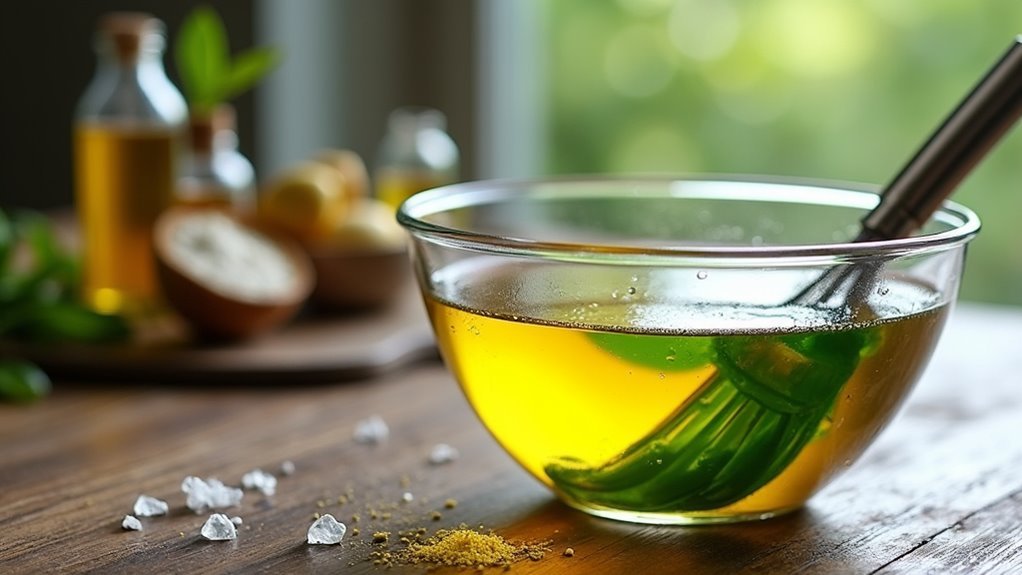
Creating the most potent wasp repellent requires precise mixing ratios and proper technique to guarantee all ingredients work together effectively.
Start with a 16oz spray bottle filled with distilled or filtered water rather than tap water to avoid impurities that reduce effectiveness. Add 4-10 drops of essential oils like peppermint, clove, or geranium along with 3 drops of dish soap for proper distribution.
Always shake the spray bottle vigorously before each application since ingredients naturally separate over time. This guarantees the essential oils distribute evenly throughout the mixture.
Focus your application on areas where you’ve spotted wasps frequently, including direct nest treatment to repel wasps effectively. Remember to reapply every few days or after rainfall when the scent diminishes.
Strategic Application Areas Around Your Property
Although mixing your wasp repellent correctly guarantees potency, targeting the right locations around your property determines success.
Focus your application around entry points like doors, windows, and cracks in siding where wasps typically infiltrate homes. Target outdoor dining areas, patios, and decks where food spills attract these pests.
Apply repellent in previously spotted wasp activity zones, particularly eaves, soffits, and shaded shelter areas. Don’t overlook flowering plants and gardens since wasps visit these pollination sites frequently.
Create protective barriers by treating these strategic locations thoroughly. Reapply every few days to maintain effectiveness, especially after rain washes away your repellent.
Strategic application in these high-traffic wasp zones maximizes your pest control efforts.
Timing Your Spray Applications for Best Results
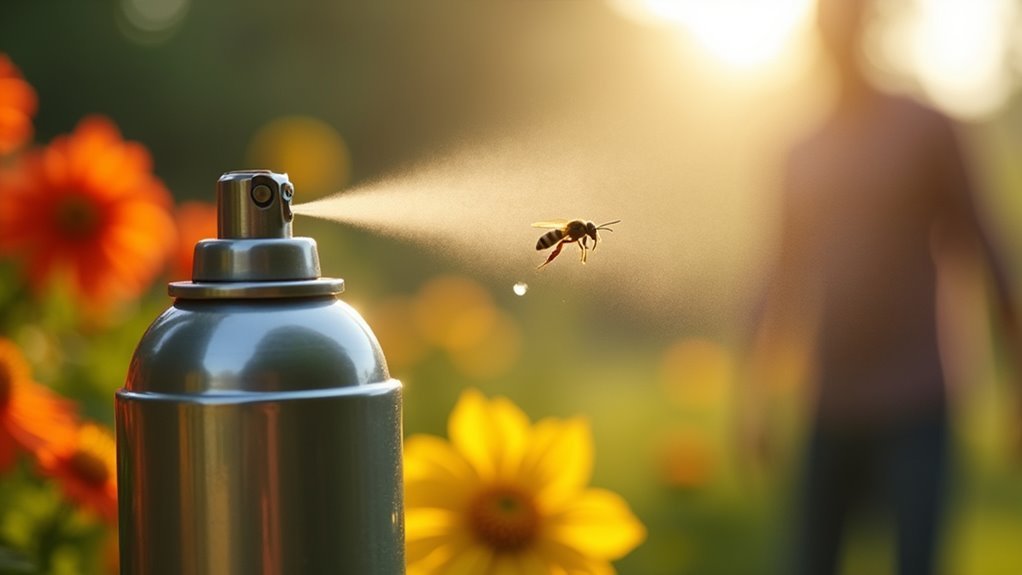
Beyond knowing where to apply your wasp repellent, you’ll achieve better results by timing your applications strategically. The timing of your spray applications greatly impacts effectiveness and your safety when dealing with wasps.
For best results, consider these timing strategies:
- Apply repellent during early morning or late evening when wasps are less active and less aggressive.
- Reapply every few days, especially after rain or heavy winds that diminish effectiveness.
- Increase application frequency during July and August when wasp activity peaks.
- Target areas where you’ve observed consistent wasp presence near nests or food sources.
- Always follow manufacturer’s timing recommendations for safe and effective use.
Consistent timing guarantees your repellent maintains its protective barrier throughout peak wasp seasons.
Safety Precautions When Using Homemade Repellents
When preparing and applying homemade wasp repellents, you’ll need to prioritize your safety precautions just as much as effectiveness. Always wear protective clothing including long sleeves, pants, gloves, and a face mask to minimize sting risks.
Safety comes first when making wasp repellents—protective gear is just as important as an effective homemade solution.
Apply your repellent during evening or early morning hours when wasps are less active and you’re less likely to encounter them.
Test your homemade mixture on a small, inconspicuous area first to verify it won’t damage surfaces or plants.
Keep children and pets at a safe distance from the treatment area during application and until the spray has completely dried.
Store your repellents in clearly labeled containers and place them out of reach to prevent accidental ingestion or misuse by curious family members.
Reapplication Schedule for Continuous Protection
To maintain effective wasp deterrence, you’ll need to establish a consistent reapplication schedule that accounts for environmental factors and seasonal wasp behavior.
For ideal protection, follow these reapplication guidelines:
- Reapply wasp repellent spray every 5 to 7 days during active seasons
- Increase application frequency after rain or heavy winds that diminish product effectiveness
- Apply treatments during evening or early morning hours when wasps are less active
- Monitor treated areas within 24 hours and reapply if wasps return to the location
- Establish weekly maintenance schedule from late spring through early fall for continuous coverage
Essential oil-based sprays typically require more frequent applications during peak wasp activity periods.
You should monitor your treated areas regularly and adjust your schedule based on observed wasp behavior.
Consistent reapplication guarantees your repellent maintains its potency throughout the season.
Combining Vinegar Sprays With Physical Deterrents
While vinegar sprays provide effective chemical deterrence, you’ll achieve superior wasp control by pairing them with strategic physical barriers and decoys.
Hang fake wasp nests or decoys around your property to exploit wasps’ territorial instincts—they won’t establish colonies where they believe other wasps already exist. Position these decoys near potential nesting sites like eaves, sheds, and covered areas.
Combine this approach with regular vinegar spray applications around the same zones for maximum effectiveness. The physical deterrents create psychological barriers while vinegar sprays eliminate scent trails and disrupt navigation patterns.
This dual strategy works exceptionally well during peak wasp season in late summer and early fall when repelling wasps becomes most challenging. Strategic placement of both creates thorough protection zones around your home.
Storage and Shelf Life of DIY Wasp Repellent Solutions
You’ll need to store your DIY wasp repellent properly to maintain its effectiveness and safety.
Proper storage methods can greatly extend your solution’s potency, while understanding expiration guidelines guarantees you’re not using degraded or potentially harmful mixtures.
Getting these basics right means you won’t waste time remaking sprays or dealing with ineffective repellents when wasps are actively threatening your outdoor spaces.
Proper Storage Methods
Proper storage can make or break your DIY wasp repellent’s effectiveness, turning a potent deterrent into a useless mixture within days if you’re not careful.
Following proper storage methods protects your essential oils from degradation while maximizing shelf life.
Here’s how to store your repellent correctly:
- Use dark containers – Choose dark glass or plastic spray bottles to shield the mixture from light exposure.
- Find cool, dark locations – Store in areas away from heat and sunlight to prevent ingredient breakdown.
- Label with dates – Mark preparation dates to track freshness and replacement schedules.
- Refrigerate when possible – Cold storage extends shelf life, especially for water-based formulations.
- Replace regularly – Most homemade repellents last 1-2 weeks maximum.
Solution Expiration Guidelines
Even with perfect storage conditions, your DIY wasp repellent won’t last indefinitely, and understanding expiration timelines helps you maintain maximum effectiveness. Your homemade solution’s shelf life typically ranges from one to three months when stored properly in cool, dark locations.
Always label containers with preparation dates to track freshness accurately. Before each application, shake the solution thoroughly to remix separated ingredients and restore potency.
Watch for warning signs like unusual odors or changed appearance—these indicate it’s time to discard the mixture immediately. Heat and sunlight exposure dramatically reduce effectiveness, so store solutions in opaque containers away from direct light.
Fresh batches deliver superior wasp-deterring performance, making regular replacement essential for continued protection around your property.
Measuring Success and Adjusting Your Spray Recipe
After you’ve applied your homemade wasp repellent spray, you’ll need to monitor its effectiveness by observing wasp activity in treated areas over several days.
Measuring success requires careful documentation of behavioral changes and environmental factors that might affect your spray’s performance.
To adjust your spray recipe effectively, consider these key strategies:
- Start with 4-10 drops of essential oils per 16oz and experiment with different concentrations
- Track weather conditions since rain and humidity can reduce effectiveness
- Increase dish soap amounts if wasps persist to enhance suffocating properties
- Document wasp behavior changes after each recipe adjustment
- Inspect treated areas regularly for new wasp activity
Frequently Asked Questions
What Is the Most Effective Wasp Deterrent?
You’ll find essential oil sprays most effective for wasp deterrence. Mix peppermint, clove, or geranium oils with dish soap in water. You’ll need to reapply regularly, but these strong scents disrupt wasp navigation effectively.
What Smell Do Wasps Hate the Most?
Peppermint stands out as the scent wasps hate most. You’ll find peppermint oil incredibly effective because wasps are extremely sensitive to its strong aroma, making it your best choice for natural wasp repulsion.
Does Vinegar Really Repel Wasps?
Yes, vinegar does repel wasps effectively. You’ll disrupt their navigation with its strong odor when you spray equal parts water and white vinegar around outdoor areas, though you’ll need regular reapplication.
What Is the Ratio of Soap to Water for Wasp Spray?
You’ll need to mix 2 tablespoons of dish soap with 1 quart of water for effective wasp spray. This ratio creates a solution that’ll suffocate wasps on contact when applied directly.
In Summary
You’ve got everything you need to create powerful wasp repellent sprays that’ll keep these pests away from your property. Don’t forget to test different essential oil combinations until you find what works best for your situation. Stay consistent with your application schedule, and you’ll see results within days. Remember, proper storage extends your spray’s effectiveness, so keep those bottles in cool, dark places. Adjust recipes as needed for maximum protection.

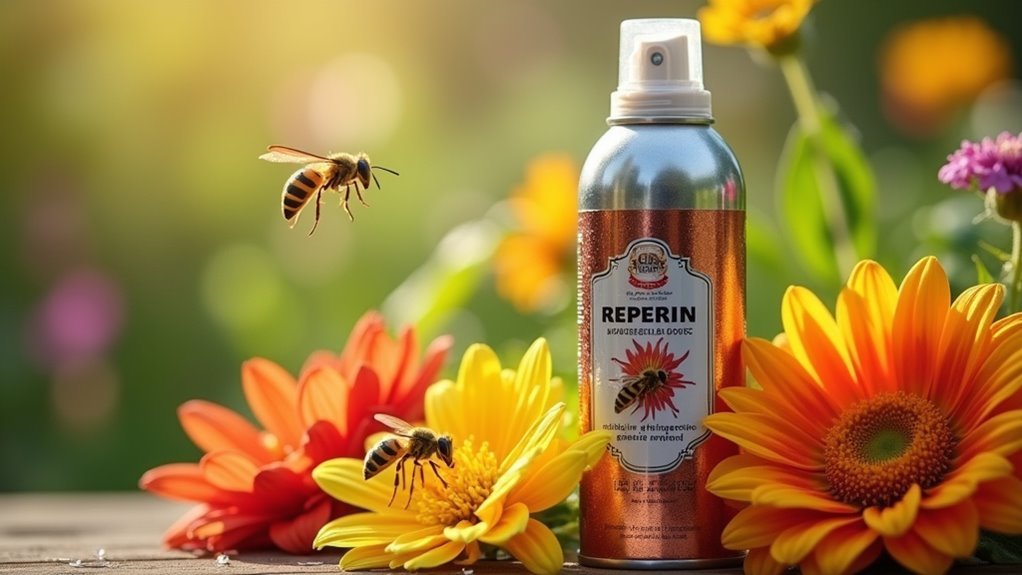
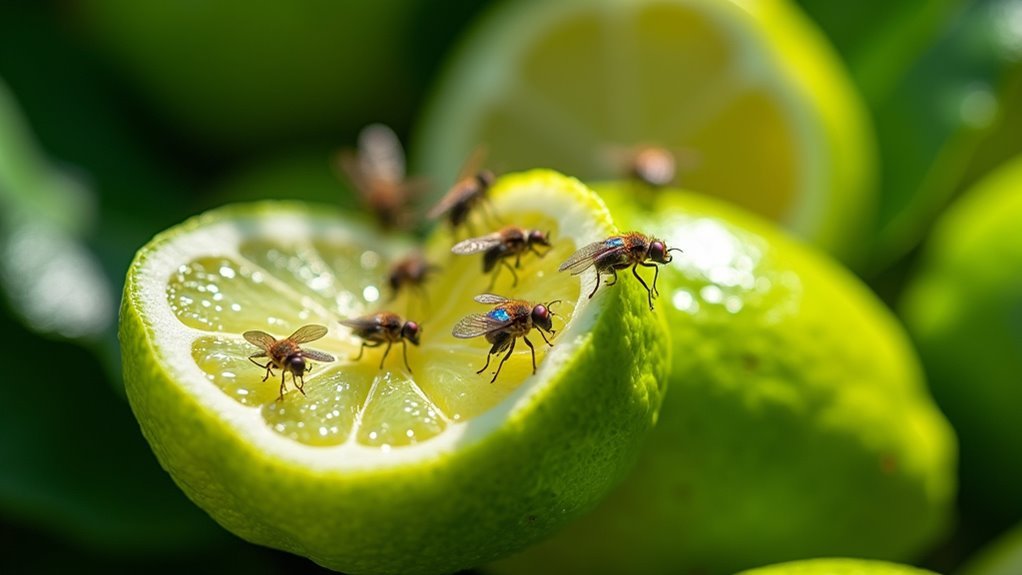
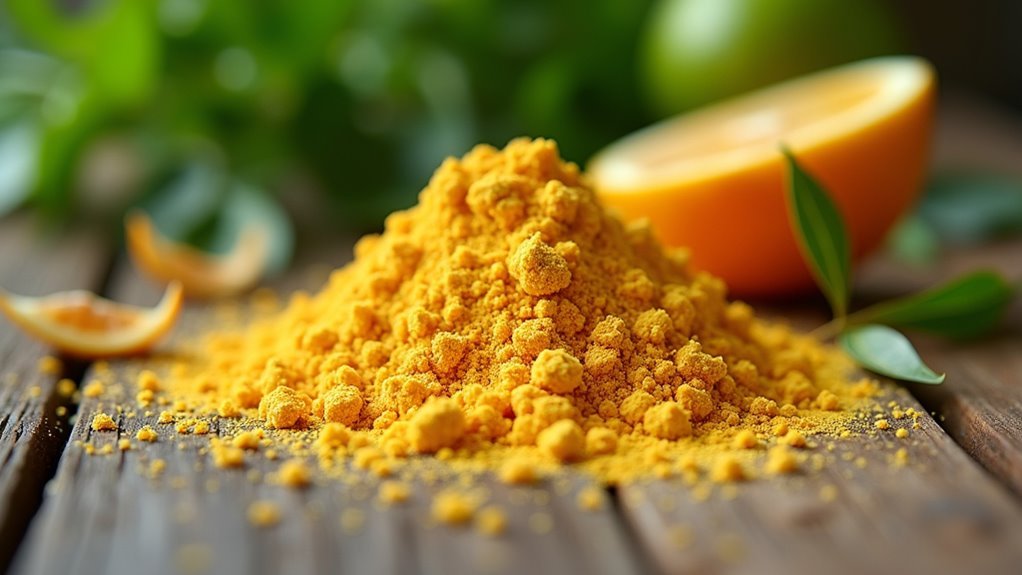
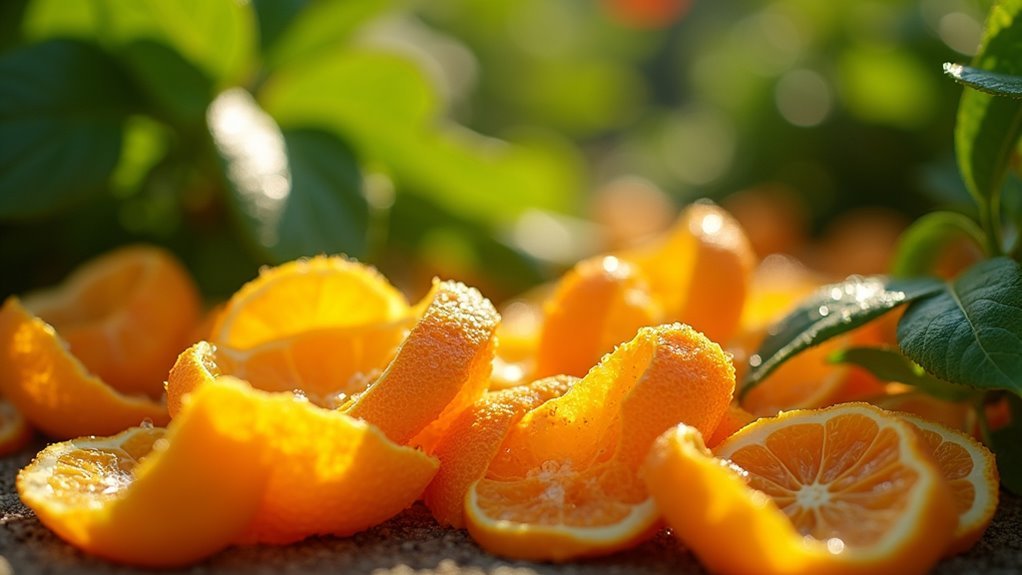
Leave a Reply